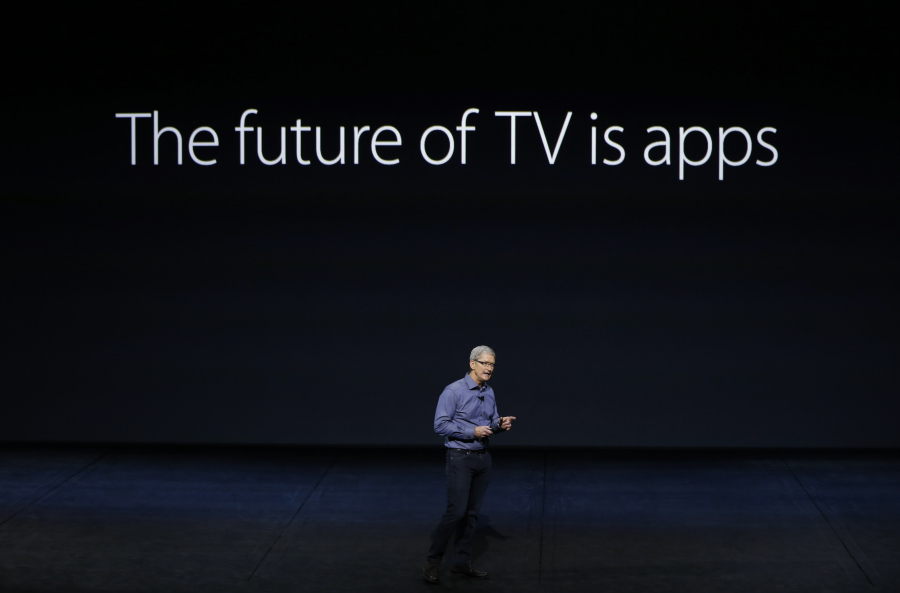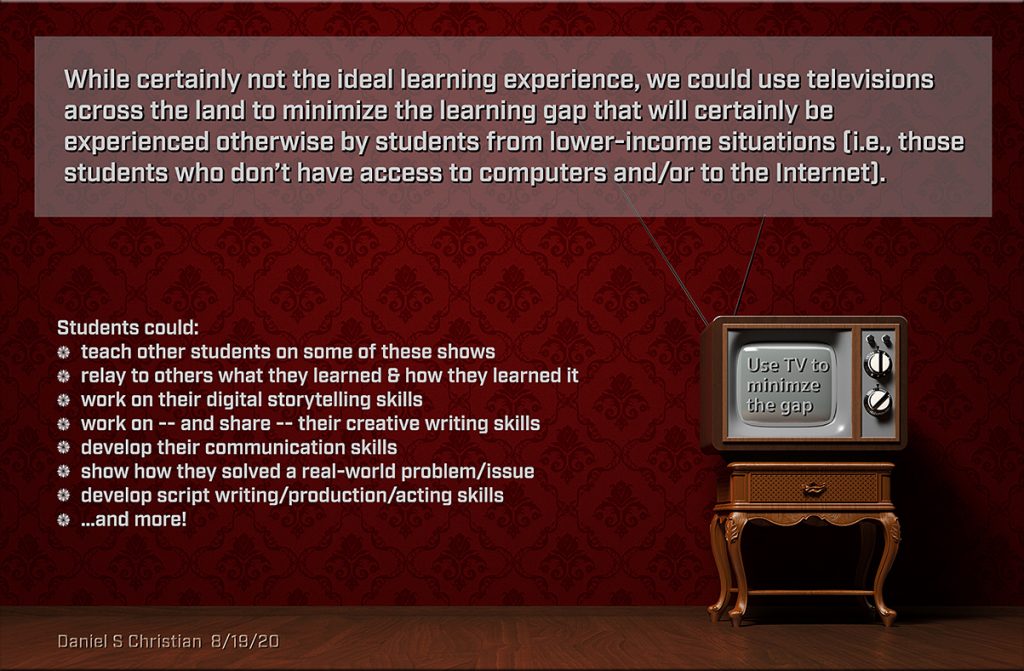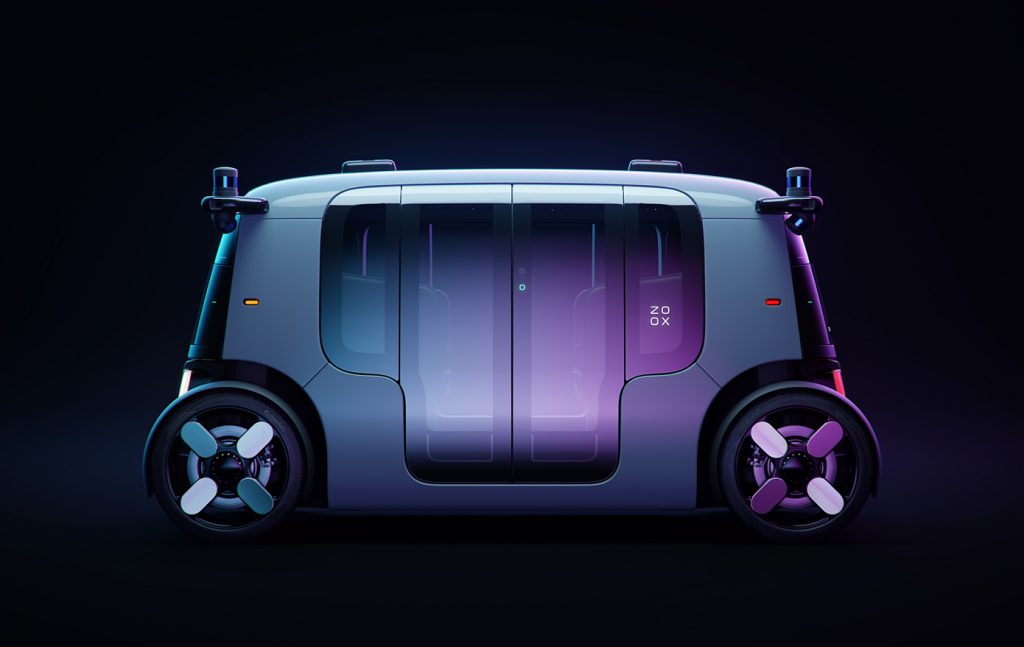A Strategic Roadmap for The Next Decade — from evolllution.com by Rob Westervelt
Excerpts:
- Get obsessed with your learner
- Adopt more than one model
- Align with partners
- Create lifelong learning models
- Build the system of the future




A Strategic Roadmap for The Next Decade — from evolllution.com by Rob Westervelt
Excerpts:
From DSC:
For me the Socratic method is still a question mark, in terms of effectiveness. (I suppose it depends on who is yielding the tool and how it’s being utilized/implemented.)
But you have one student — often standing up and/or in the spotlight — who is being drilled on something. That student could be calm and collected, and their cognitive processing could actually get a boost from the adrenaline.
But there are other students who dread being called upon in such a public — sometimes competitive — setting. Their cognitive processing could shut down or become greatly diminished.
Also, the professor is working with one student at a time — hopefully the other students are trying to address each subsequent question, but some students may tune out once they know it’s not their turn in the spotlight.
So I was wondering…could the Socratic method be used with each student at the same time? Could a polling-like tool be used in real-time to guide the discussion?
For example, a professor could start out with a pre-created poll and ask the question of all students. Then they could glance through the responses and even scan for some keywords (using their voice to drive the system and/or using a Ctrl+F / Command+F type of thing).
Then in real-time / on-the-fly, could the professor use their voice to create another poll/question — again for each student to answer — based on one of the responses? Again, each student must answer the follow up question(s).
Are there any vendors out there working on something like this? Or have you tested the effectiveness of something like this?
Vendors: Can you help us create a voice-driven interface to offer the Socratic method to everyone to see if and how it would work? (Like a Mentimeter type of product on steroids…er, rather, using an AI-driven backend.)
Teachers, trainers, pastors, presenters could also benefit from something like this — as it could engage numerous people at once.
#Participation #Engagement #Assessment #Reasoning #CriticalThinking #CommunicationSkills #ThinkingOnOnesFeet #OnlineLearning #Face-to-Face #BlendedLearning #HybridLearning
Could such a method be used in language-related classes as well? In online-based tutoring?
The Year TV Leaped Into The Future — from protocol.com by Janko Roettgers
The lockdowns this year have transformed our homes into offices, schools, concert halls, movie theaters and gyms. Our homes are working harder for us, but so is our technology. The device that is working the hardest is perhaps the TV—becoming our lifeline to a far more virtual world.
Addendums:
The Second Year of The MOOC: 2020 Saw a Rush to Large-Scale Online Courses — from edsurge.com by Dhawal Shah
Excerpt:
This was the year that more people learned what a MOOC is.
As millions suddenly found themselves with free time on their hands during the pandemic, many turned to online courses—especially, to free courses known as MOOCs, or Massive Open Online Courses. This phenomenon was compounded by media worldwide compiling lists of “free things to do during lockdown,” which tended to include MOOCs.
Within two months, Class Central had received over 10 million visits and sent over six million clicks to MOOC providers. These learners also turned out to be more engaged than usual. In April 2020, MOOC providers Coursera, edX and FutureLearn attracted as many new users in a single month as they did in the entirety of 2019.
.
From DSC:
The pieces continue to come together…
...team-based content creation and delivery will dominate in the future (at least for the masses). It will offer engaging, personalized learning and the AI-based systems will be constantly scanning for the required/sought-after skills and competencies. The systems will then present a listing of items that will help people obtain those skills and competencies.
#AI #LearningProfiles #Cloud #LearningFromTheLivingClassRoom #LearningEcosystems #LearningSpaces #21stCentury #24x7x365 #Reinvent #Surviving #StayingRelevant #LifeLongLearning and many more tags/categories are applicable here.
Amazon’s Zoox unveils electric robotaxi that can travel up to 75 mph — from techcrunch.com by Kirsten Korosec
Teaching with Amazon Alexa — from Sylvia Martinez
Excerpt:
Alexa is a voice-activated, cloud-based virtual assistant, similar to Siri on Apple devices, or Google Assistant. Alexa is an umbrella name for the cloud-based functionality that responds to verbal commands. Alexa uses artificial intelligence to answer questions or control smart devices, and has a range of “skills” — small programs that you can add to increase Alexa’s capabilities.
Many teachers are experimenting with using smart devices like Alexa in the classroom. Like most other Amazon features and products, Alexa is primarily designed for home use, anticipating that users will be household members. So in thinking about Alexa in a classroom, keeping this in mind will help determine the best educational uses.
Alexa is most often accessed in three ways…
Designed to Deceive: Do These People Look Real to You? — from nytimes.com by Kashmir Hill and Jeremy White
These people may look familiar, like ones you’ve seen on Facebook or Twitter. Or people whose product reviews you’ve read on Amazon, or dating profiles you’ve seen on Tinder. They look stunningly real at first glance. But they do not exist. They were born from the mind of a computer. And the technology that makes them is improving at a startling pace.
Is this humility or hubris? Do we place too little value in human intelligence — or do we overrate it, assuming we are so smart that we can create things smarter still?
The Digital Divide for Tribal College Students — COVID, CARES Act, and Critical Next Steps — from diverseeducation.com
Excerpt:
In this episode staff writer Sara Weissman shares a story that focuses on the digital divide for Native Americans by bringing in voices of tribal college leaders and their students during the COVID 19 pandemic.
Many don’t know but Native American colleges and universities have long struggled with the worst internet connectivity in the nation while ironically paying the highest rates for service. Hear first-hand how students from Diné College and other institutions are currently affected. Carrie Billie (Big Water Clan), President & CEO of the American Indian Higher Education Consortium (AIHEC) and Dr. Cynthia Lindquist (Star Horse Woman), President of Cankdeska Cikana Community College in North Dakota, break down the data and lay out critical next steps necessary to address the digital divide.
Many don’t know but Native American colleges and universities have long struggled with the worst internet connectivity in the nation while ironically paying the highest rates for service.
From DSC:
When will there be justice!? Let’s join in and make amends and provide the funding, concrete assistance, products, and services to Native American colleges, universities, and communities. Some potential ideas:
We need to do the right thing here. This is another area* where our nation can do much better.
* Here’s another example/area where we can do much better and make amends/changes.
Addendum on 12/7/20:
From DSC:
The good…
London A.I. lab claims breakthrough that could accelerate drug discovery — from nytimes.com by
Researchers at DeepMind say they have solved “the protein folding problem,” a task that has bedeviled scientists for more than 50 years
This long-sought breakthrough could accelerate the ability to understand diseases, develop new medicines and unlock mysteries of the human body.
…and the not so good…
Hmmm…can’t imagine anyone slipping on this slippery slope in the future. https://t.co/h2lZcpAh02
— Daniel Christian (he/him/his) (@dchristian5) December 3, 2020
Amazon Expands AWS Cloud Training Program — from campustechnology.com by Dian Schaffhauser
Excerpt:
Each tuition-free program is intended to help unemployed and underemployed people — especially those in underrepresented demographics — gain new skills in cloud computing to help them get entry-level jobs in a high-demand field. Students work through scenario-based learning, hands-on labs and coursework.
The training is provided by three organizations: Year Up in San Jose and San Francisco; New College Institute in Martinsville; and Per Scholas in Boston, Washington, DC, New York and Newark.
From DSC:
Very interesting…
From DSC:
Who needs to be discussing/debating “The Social Dilemma” movie? Whether one agrees with the perspectives put forth therein or not, the discussion boards out there should be lighting up in the undergraduate areas of Computer Science (especially Programming), Engineering, Business, Economics, Mathematics, Statistics, Philosophy, Religion, Political Science, Sociology, and perhaps other disciplines as well.
To those starting out the relevant careers here…just because we can, doesn’t mean we should. Ask yourself not whether something CAN be developed, but *whether it SHOULD be developed* and what the potential implications of a technology/invention/etc. might be. I’m not aiming to take a position here. Rather, I’m trying to promote some serious reflection for those developing our new, emerging technologies and our new products/services out there.
Learning in the Cloud: Canada’s First University to Move Operations into One Secure Cloud Infrastructure Sets the Stage for the Future of Learning — from globenewswire.com by Athabasca University
Athabasca University (AU) lays the groundwork to build a more accessible and personalized future for post-secondary learners
Excerpt:
Edmonton, Alberta, Sept. 23, 2020 (GLOBE NEWSWIRE) — At a time when you can personalize everything from your online shopping experience to your dating prospects, it seems only reasonable to ask: why can’t students “swipe right” on their course load? Why can’t a degree be structured around what someone wants to learn or how they learn, instead of what’s traditionally part of the program? In other words, why isn’t it possible to choose your own adventure in a university environment?
Athabasca University (AU), Canada’s Online University, recently completed a six-month rapid cloud migration project with Amazon Web Services (AWS) to construct a secure, flexible, and global infrastructure required to make personalized learning an infinitely scalable reality. With the completion of its cloud migration project, AU became the first post-secondary institution in Canada to move its entire digital operations infrastructure into its own secure AU cloud environment powered by AWS.
Walmart just started delivering stuff with drones — from futurism.com by Victor Tangermann
Excerpt:
Walmart just kicked off its own drone delivery pilot, a collaboration with drone delivery company Flytrex. The pilot launched today in Fayetteville, North Carolina, and is limited to select grocery and household essential items from the retailer’s local stores.
From DSC:
It starts off with an army of drones from Walmart joined by another army of drones from Amazon.
Then company XYZ chimes in. Then company ABC chimes in. And so on, and so on, and so on.
Then the armies of drones change to more powerful, louder, more “capable” delivery vehicles that can handle bigger, heavier deliveries.
And suddenly, the skies are full of noise-making, sun-blocking pieces of human-made machinery that, for the most part, are convenient but not necessary.
We need to think — and act — very carefully these days.
Is this the future we want to create? Not me. I, for one, appreciate a quiet walk. I appreciate being able to look up at the skies, especially when they are clear.

To the relevant engineers and C-Suites out there:
Let’s shut this down — now — before the momentum gets started. Let’s follow Portland’s example by shutting down facial recognition/AI:
1/2 “Some experts warn that training students or job seekers in skills that corporations say they want might not guarantee a job at the company, and might result in time wasted if the skill falls out of fashion within a few years.” https://t.co/aWZHMx7bsG
— Daniel Christian (@dchristian5) August 21, 2020
#lifelonglearning #stayingrelevant #reinvent #learning #surviving
Speaking of career-related items…also see the powerful commentary out at:
From DSC:
That article reminded me that there are a variety of people working on the “front lines” of this pandemic.

From DSC:
A few years ago, I had hoped that Apple was going to go all-in with their tvOS platform.

SAN FRANCISCO, CA – SEPTEMBER 9: Apple CEO Tim Cook introduces the New Apple TV during a Special Event; 9/9/15.
Though it’s still early in the game, that really hasn’t happened to the extent that I had hoped. That said, more recently, I was encouraged to see this article from back in July:
Let’s ask the employees of PBS, ABC, CBS, NBC, Fox, and other networks if they would be willing to work with the U.S. Department of Education to help educate ALL students! Though educational TV is not new, I’m talking about taking things to a *whole* new level.
With that in mind, I created the following graphic:

(One might ask why I used an old television in the above graphic. I was trying to get at the idea that one might not have a lot of resources to work with.)
From DSC:
For current and/or future data scientists out there.
Required Skills
The data analyst position at Amazon requires specialization in knowledge and experience. Therefore, Amazon only hires highly qualified candidates with at least 3 years of industry experience working with data analysis, data modelling, advanced business analytics, and other related fields.
Other basic qualifications include:
